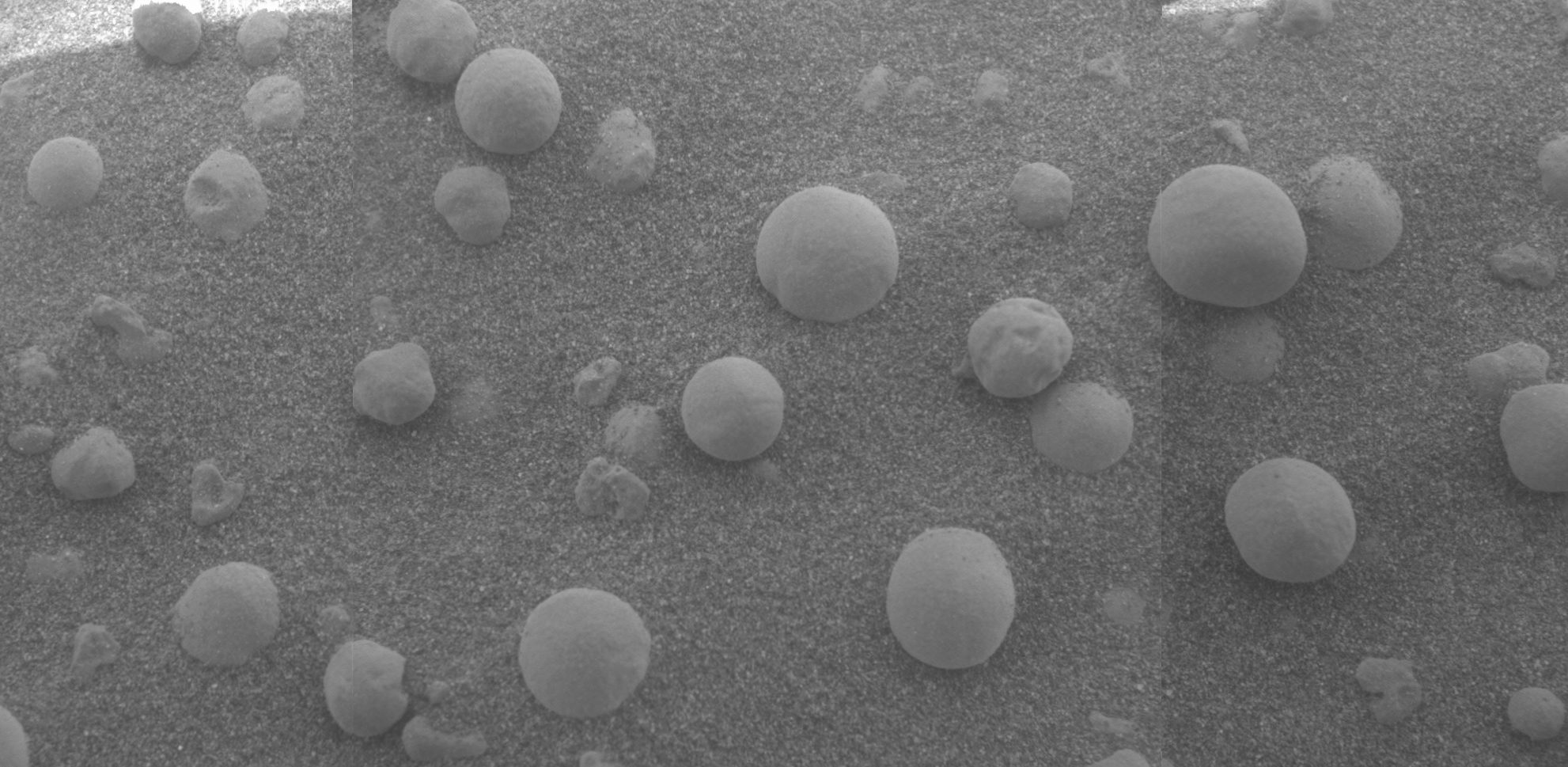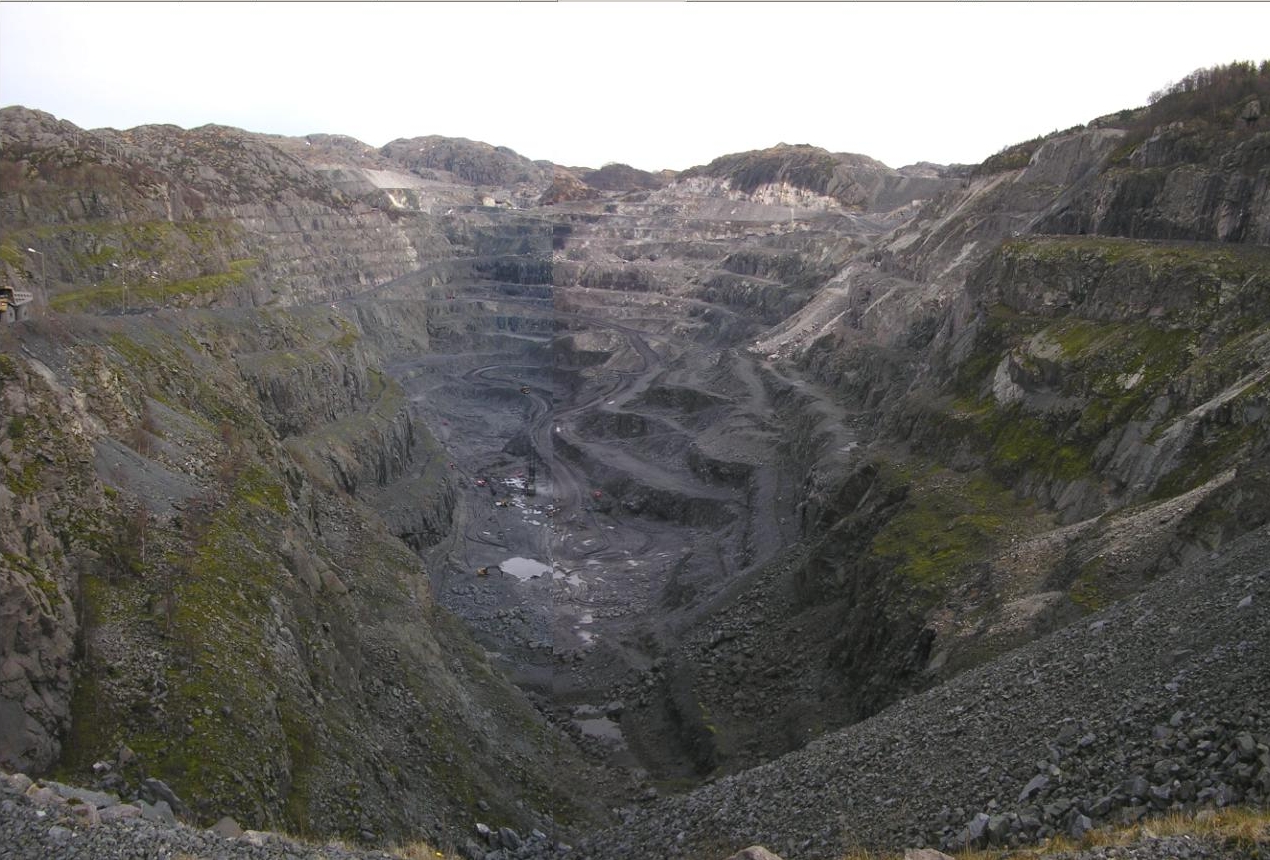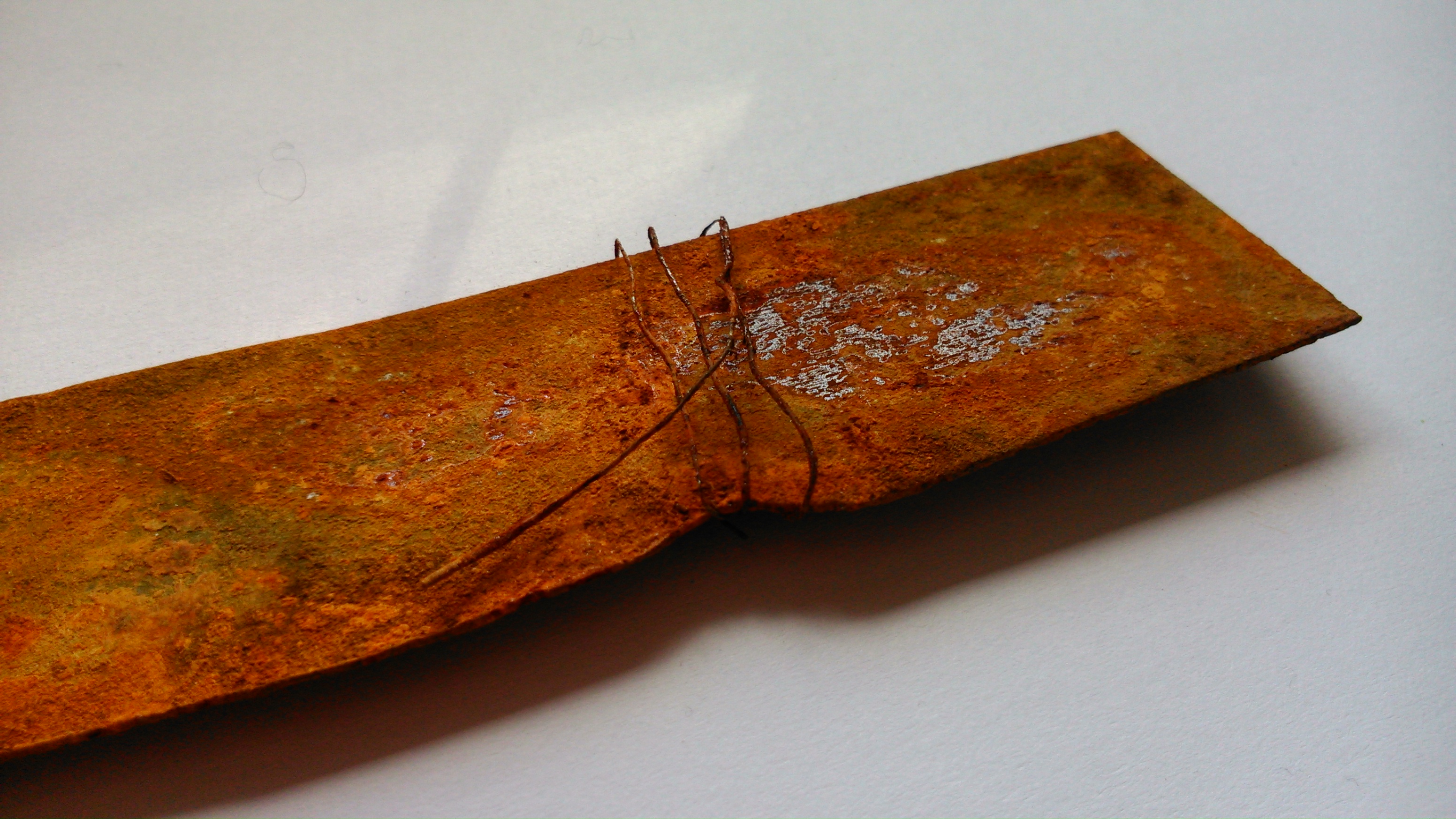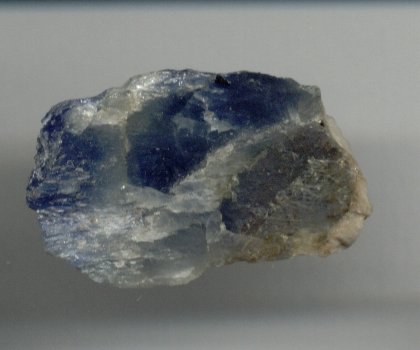|
Hematite
Hematite (), also spelled as haematite, is a common iron oxide compound with the formula, Fe2O3 and is widely found in rocks and soils. Hematite crystals belong to the rhombohedral lattice system which is designated the alpha polymorph of . It has the same crystal structure as corundum () and ilmenite (). With this it forms a complete solid solution at temperatures above . Hematite occurs naturally in black to steel or silver-gray, brown to reddish-brown, or red colors. It is mined as an important ore mineral of iron. It is electrically conductive. Hematite varieties include ''kidney ore'', ''martite'' ( pseudomorphs after magnetite), ''iron rose'' and ''specularite'' ( specular hematite). While these forms vary, they all have a rust-red streak. Hematite is not only harder than pure iron, but also much more brittle. The term ''kidney ore'' may be broadly used to describe botryoidal, mammillary, or reniform hematite. Maghemite is a polymorph of hematite (γ-) with the ... [...More Info...] [...Related Items...] OR: [Wikipedia] [Google] [Baidu] |
Iron Ore
Iron ores are rocks and minerals from which metallic iron can be economically extracted. The ores are usually rich in iron oxides and vary in color from dark grey, bright yellow, or deep purple to rusty red. The iron is usually found in the form of magnetite (, 72.4% Fe), hematite (, 69.9% Fe), goethite (, 62.9% Fe), limonite (, 55% Fe), or siderite (, 48.2% Fe). Ores containing very high quantities of hematite or magnetite (typically greater than about 60% iron) are known as natural ore or irect shipping ore and can be fed directly into iron-making blast furnaces. Iron ore is the raw material used to make pig iron, which is one of the main raw materials to make steel — 98% of the mined iron ore is used to make steel. In 2011 the ''Financial Times'' quoted Christopher LaFemina, mining analyst at Barclays Capital, saying that iron ore is "more integral to the global economy than any other commodity, except perhaps oil". Sources Elemental iron is virtually absent o ... [...More Info...] [...Related Items...] OR: [Wikipedia] [Google] [Baidu] |
Banded Iron Formation
Banded iron formations (BIFs; also called banded ironstone formations) are distinctive units of sedimentary rock consisting of alternating layers of iron oxides and iron-poor chert. They can be up to several hundred meters in thickness and extend laterally for several hundred kilometers. Almost all of these formations are of Precambrian age and are thought to record the Great Oxygenation Event, oxygenation of the Earth's oceans. Some of the Earth's oldest rock formations, which formed about (Year#SI prefix multipliers, Ma), are associated with banded iron formations. Banded iron formations are thought to have formed in sea water as the result of oxygen production by photosynthesis, photosynthetic cyanobacteria. The oxygen combined with dissolved iron in Earth's oceans to form insoluble iron oxides, which precipitated out, forming a thin layer on the ocean floor. Each band is similar to a varve, resulting from cyclic variations in oxygen production. Banded iron formations we ... [...More Info...] [...Related Items...] OR: [Wikipedia] [Google] [Baidu] |
Ilmenite
Ilmenite is a titanium-iron oxide mineral with the idealized formula . It is a weakly magnetic black or steel-gray solid. Ilmenite is the most important ore of titanium and the main source of titanium dioxide, which is used in paints, printing inks, fabrics, plastics, paper, sunscreen, food and cosmetics. Structure and properties Ilmenite is a heavy (specific gravity 4.7), moderately hard (Mohs hardness 5.6 to 6), opaque black mineral with a submetallic luster. It is almost always massive, with thick tabular crystals being quite rare. It shows no discernible cleavage, breaking instead with a conchoidal to uneven fracture. Ilmenite crystallizes in the trigonal system with space group ''R''. The ilmenite crystal structure consists of an ordered derivative of the corundum structure; in corundum all cations are identical but in ilmenite Fe2+ and Ti4+ ions occupy alternating layers perpendicular to the trigonal c axis. Pure ilmenite is paramagnetic (showing only very weak ... [...More Info...] [...Related Items...] OR: [Wikipedia] [Google] [Baidu] |
Crystal Habit
In mineralogy, crystal habit is the characteristic external shape of an individual crystal or aggregate of crystals. The habit of a crystal is dependent on its crystallographic form and growth conditions, which generally creates irregularities due to limited space in the Crystallization, crystallizing medium (commonly in Rock (geology), rocks).Klein, Cornelis, 2007, ''Minerals and Rocks: Exercises in Crystal and Mineral Chemistry, Crystallography, X-ray Powder Diffraction, Mineral and Rock Identification, and Ore Mineralogy,'' Wiley, third edition, Wenk, Hans-Rudolph and Andrei Bulakh, 2004, ''Minerals: Their Constitution and Origin,'' Cambridge, first edition, Crystal forms Recognizing the habit can aid in mineral identification and description, as the crystal habit is an external representation of the Crystal structure, internal ordered atomic arrangement. Most natural crystals, however, do not display ideal habits and are commonly malformed. Hence, it is also important to des ... [...More Info...] [...Related Items...] OR: [Wikipedia] [Google] [Baidu] |
Iron(III) Oxide
Iron(III) oxide or ferric oxide is the inorganic compound with the formula . It occurs in nature as the mineral hematite, which serves as the primary source of iron for the steel industry. It is also known as red iron oxide, especially when used in pigments. It is one of the three main oxides of iron, the other two being iron(II) oxide (FeO), which is rare; and iron(II,III) oxide (), which also occurs naturally as the mineral magnetite. Iron(III) oxide is often called rust, since rust shares several properties and has a similar composition; however, in chemistry, rust is considered an ill-defined material, described as hydrous ferric oxide. Ferric oxide is readily attacked by even weak acids. It is a weak oxidising agent, most famously when reduced by aluminium in the thermite reaction. Structure can be obtained in various polymorphs. In the primary polymorph, α, iron adopts octahedral coordination geometry. That is, each Fe center is bound to six oxygen ligands. In t ... [...More Info...] [...Related Items...] OR: [Wikipedia] [Google] [Baidu] |
Magnetite
Magnetite is a mineral and one of the main iron ores, with the chemical formula . It is one of the iron oxide, oxides of iron, and is ferrimagnetism, ferrimagnetic; it is attracted to a magnet and can be magnetization, magnetized to become a permanent magnet itself. With the exception of extremely rare native iron deposits, it is the most magnetic of all the naturally occurring minerals on Earth. Naturally magnetized pieces of magnetite, called lodestone, will attract small pieces of iron, which is how ancient peoples first discovered the property of magnetism. Magnetite is black or brownish-black with a metallic luster, has a Mohs scale of mineral hardness, Mohs hardness of 5–6 and leaves a black streak (mineralogy), streak. Small grains of magnetite are very common in igneous rocks, igneous and metamorphic rocks. The chemical IUPAC name is iron(II,III) oxide and the common chemical name is ''ferrous-ferric oxide''. Properties In addition to igneous rocks, magnetite als ... [...More Info...] [...Related Items...] OR: [Wikipedia] [Google] [Baidu] |
Iron(III) Oxide
Iron(III) oxide or ferric oxide is the inorganic compound with the formula . It occurs in nature as the mineral hematite, which serves as the primary source of iron for the steel industry. It is also known as red iron oxide, especially when used in pigments. It is one of the three main oxides of iron, the other two being iron(II) oxide (FeO), which is rare; and iron(II,III) oxide (), which also occurs naturally as the mineral magnetite. Iron(III) oxide is often called rust, since rust shares several properties and has a similar composition; however, in chemistry, rust is considered an ill-defined material, described as hydrous ferric oxide. Ferric oxide is readily attacked by even weak acids. It is a weak oxidising agent, most famously when reduced by aluminium in the thermite reaction. Structure can be obtained in various polymorphs. In the primary polymorph, α, iron adopts octahedral coordination geometry. That is, each Fe center is bound to six oxygen ligands. In t ... [...More Info...] [...Related Items...] OR: [Wikipedia] [Google] [Baidu] |
Maghemite
Maghemite (Fe2O3, γ-Fe2O3) is a member of the family of iron oxides. It has the same formula as hematite, but the same spinel ferrite structure as magnetite () and is also ferrimagnetic. It is sometimes spelled as "maghaemite". ''Maghemite'' can be considered as an Fe(II)-deficient magnetite with formula \left(\ce\right)_A\left ce\rightB\ce where \square represents a vacancy, A indicates tetrahedral and B octahedral positioning. Occurrence Maghemite forms by weathering or low-temperature oxidation of spinels containing iron(II) such as magnetite or titanomagnetite. Maghemite can also form through dehydration and transformation of certain iron oxyhydroxide minerals, such as lepidocrocite and ferrihydrite. It occurs as widespread brown or yellow pigment in terrestrial sediments and soils. It is associated with magnetite, ilmenite, anatase, pyrite, marcasite, lepidocrocite and goethite. It is known to also form in areas that have been subjected to bushfires (particularly ... [...More Info...] [...Related Items...] OR: [Wikipedia] [Google] [Baidu] |
Iron Oxide
An iron oxide is a chemical compound composed of iron and oxygen. Several iron oxides are recognized. Often they are non-stoichiometric. Ferric oxyhydroxides are a related class of compounds, perhaps the best known of which is rust. Iron oxides and oxyhydroxides are widespread in nature and play an important role in many geological and biological processes. They are used as iron ores, pigments, catalysts, and in thermite, and occur in hemoglobin. Iron oxides are inexpensive and durable pigments in paints, coatings and colored concretes. Colors commonly available are in the " earthy" end of the yellow/orange/red/brown/black range. When used as a food coloring, it has E number E172. Stoichiometries Iron oxides feature as ferrous ( Fe(II)) or ferric ( Fe(III)) or both. They adopt octahedral or tetrahedral coordination geometry. Only a few oxides are significant at the earth's surface, particularly wüstite, magnetite, and hematite. * Oxides of FeII ** FeO: ir ... [...More Info...] [...Related Items...] OR: [Wikipedia] [Google] [Baidu] |
Corundum
Corundum is a crystalline form of aluminium oxide () typically containing traces of iron, titanium, vanadium, and chromium. It is a rock (geology), rock-forming mineral. It is a naturally transparency and translucency, transparent material, but can have different colors depending on the presence of transition metal impurities in its crystalline structure. Corundum has two primary gemstone, gem varieties: ruby and sapphire. Rubies are red due to the presence of chromium, and sapphires exhibit a range of colors depending on what transition metal is present. A rare type of sapphire, Sapphire#Padparadscha, padparadscha sapphire, is pink-orange. The name "corundum" is derived from the Tamil language, Tamil-Dravidian languages, Dravidian word ''kurundam'' (ruby-sapphire) (appearing in Sanskrit as ''kuruvinda''). Because of corundum's hardness (pure corundum is defined to have 9.0 on the Mohs scale), it can scratch almost all other minerals. Emery (rock), Emery, a variety of corundum w ... [...More Info...] [...Related Items...] OR: [Wikipedia] [Google] [Baidu] |
Trigonal Crystal System
In crystallography, the hexagonal crystal family is one of the six crystal families, which includes two crystal systems (hexagonal and trigonal) and two lattice systems (hexagonal and rhombohedral). While commonly confused, the trigonal crystal system and the rhombohedral lattice system are not equivalent (see section crystal systems below). In particular, there are crystals that have trigonal symmetry but belong to the hexagonal lattice (such as α-quartz). The hexagonal crystal family consists of the 12 point groups such that at least one of their space groups has the hexagonal lattice as underlying lattice, and is the union of the hexagonal crystal system and the trigonal crystal system. There are 52 space groups associated with it, which are exactly those whose Bravais lattice is either hexagonal or rhombohedral. __TOC__ Lattice systems The hexagonal crystal family consists of two lattice systems: hexagonal and rhombohedral. Each lattice system consists of one Bravais lat ... [...More Info...] [...Related Items...] OR: [Wikipedia] [Google] [Baidu] |
Streak (mineralogy)
The streak of a mineral is the color of the powder produced when it is dragged across an unweathered surface. Unlike the apparent color of a mineral, which for most minerals can vary considerably, the trail of finely ground powder generally has a more consistent characteristic color, and is thus an important diagnostic tool in mineral identification. If no streak seems to be made, the mineral's streak is said to be white or colorless. Streak is particularly important as a diagnostic for opaque and colored materials. It is less useful for silicate minerals, most of which have a white streak or are too hard to powder easily. The apparent color of a mineral can vary widely because of trace impurities or a disturbed macroscopic crystal structure. Small amounts of an impurity that strongly absorbs a particular wavelength can radically change the wavelengths of light that are reflected by the specimen, and thus change the apparent color. However, when the specimen is dragged to produce ... [...More Info...] [...Related Items...] OR: [Wikipedia] [Google] [Baidu] |








